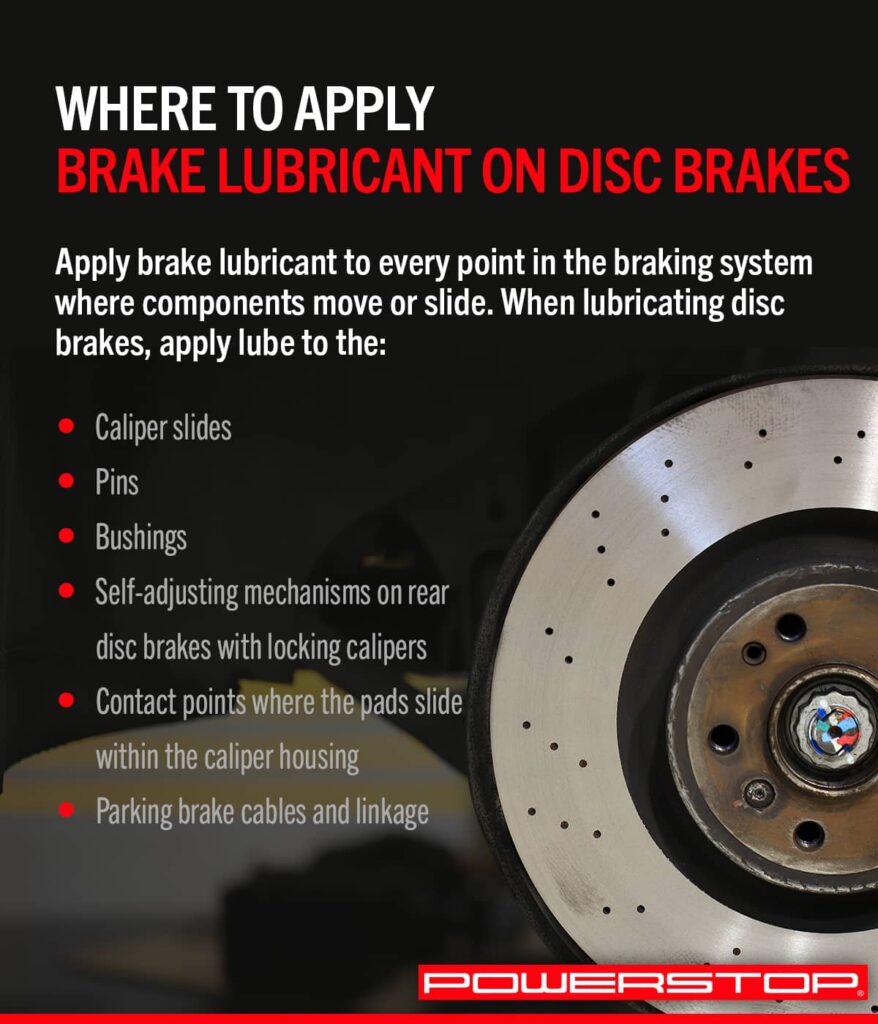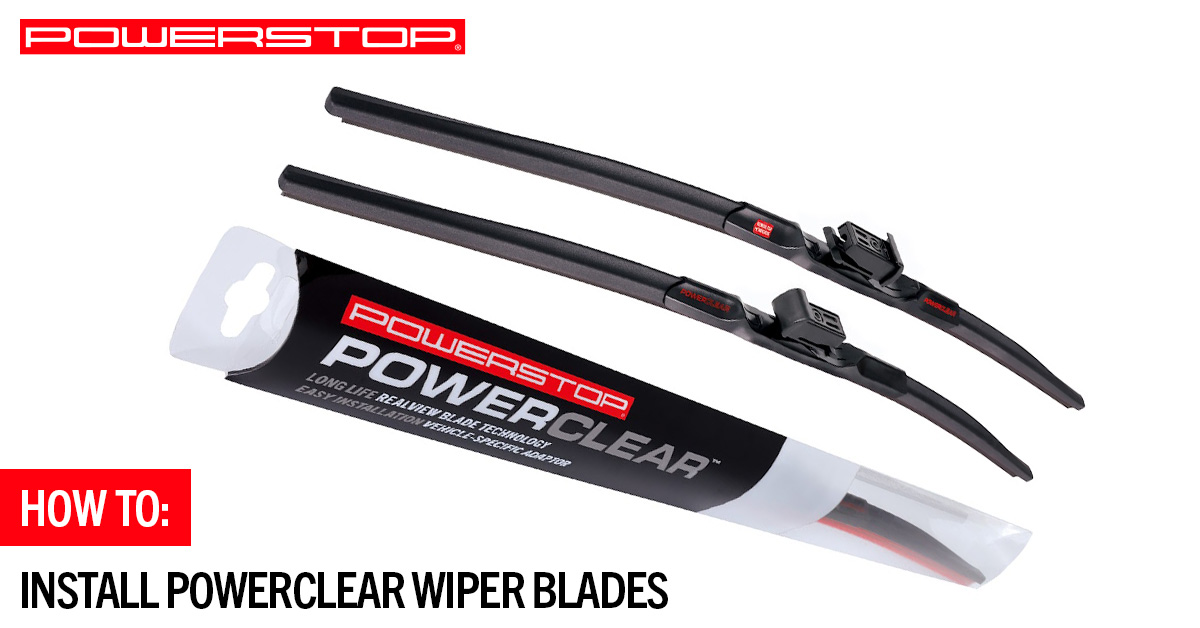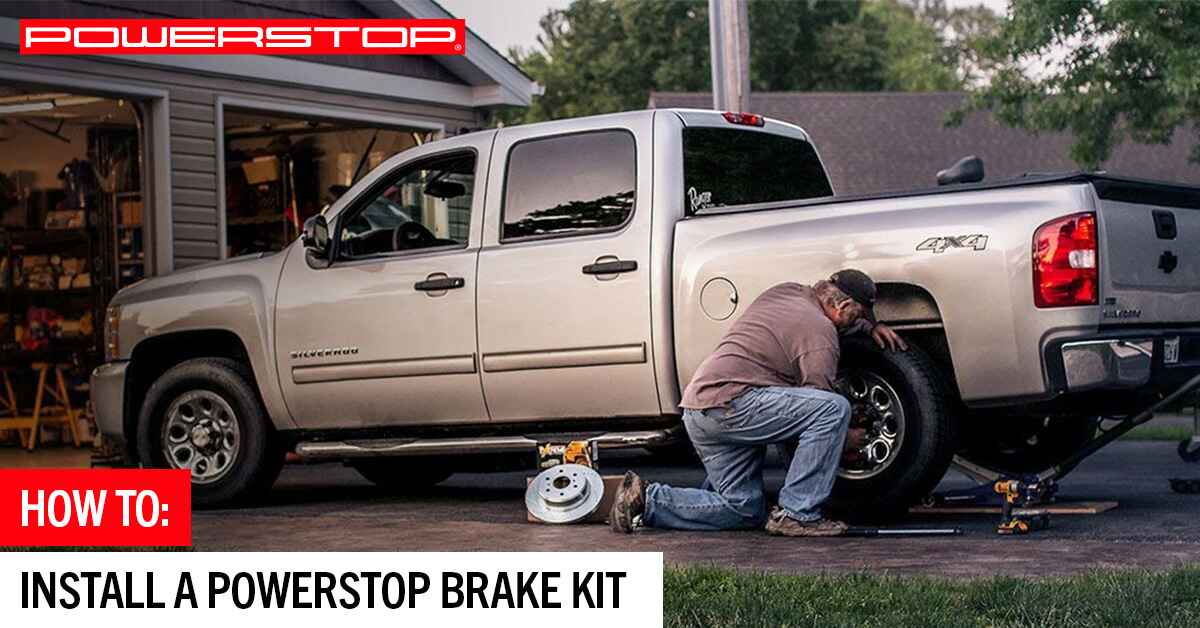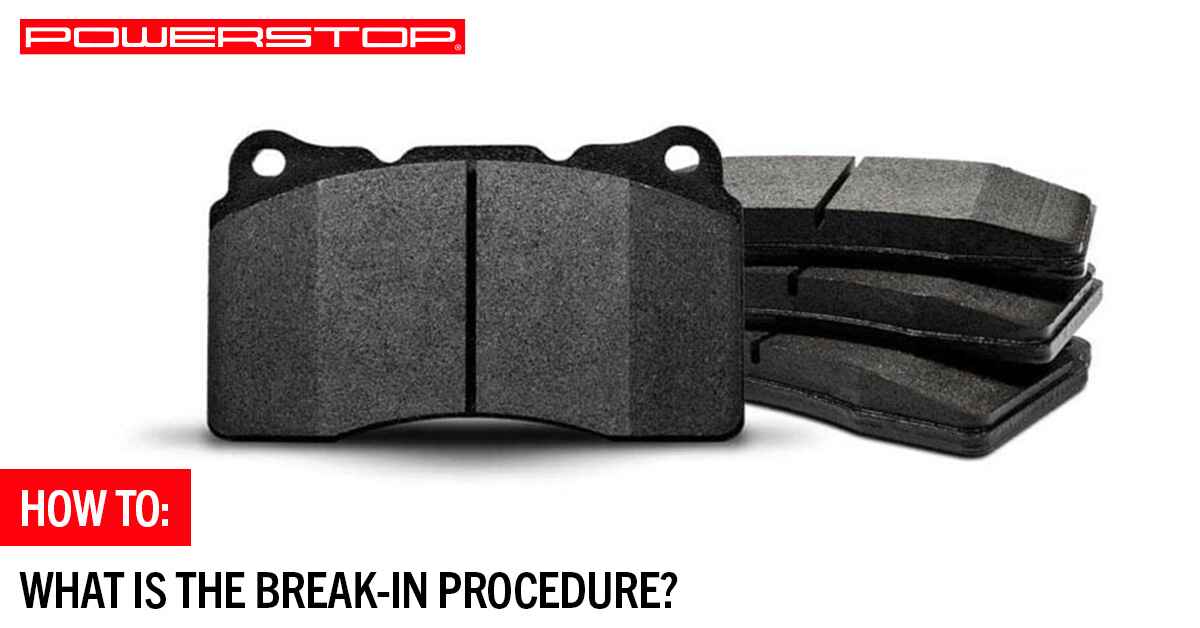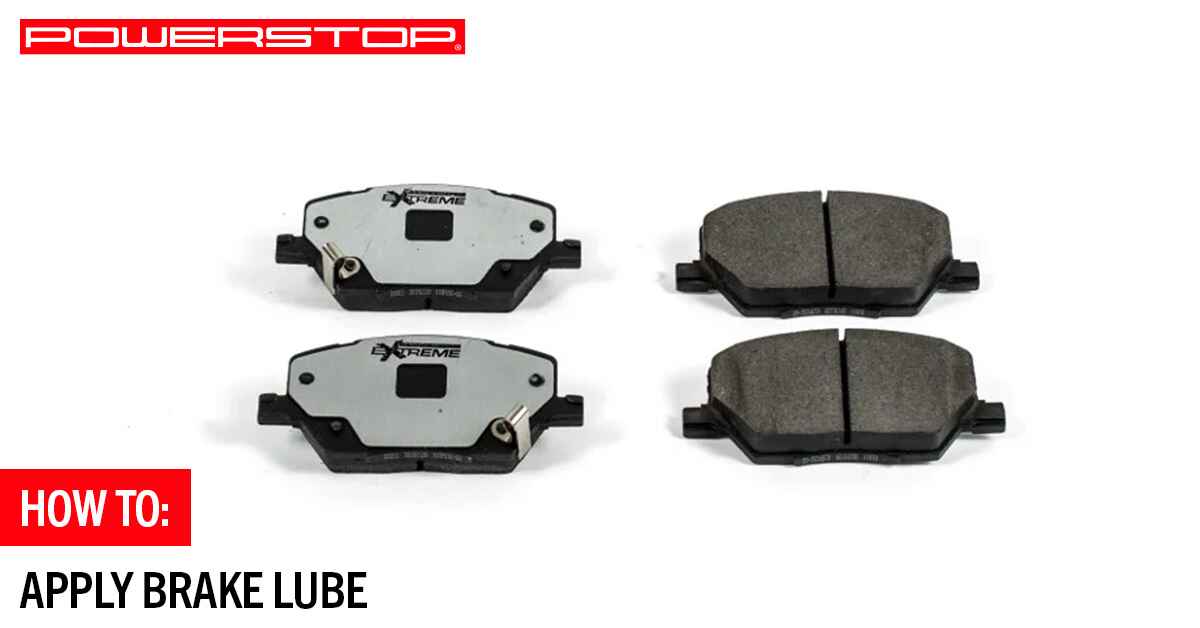
How To Apply Brake Lube
Your vehicle’s brakes use friction to slow down and stop. During the braking process, brake pads are hydraulically pressed against the brake rotor. While it may seem counterintuitive to use lube on a system that relies on friction, lubrication is essential to brake function.
Ensuring that your brakes work properly is one of the most important steps you can take as a vehicle owner. Your safety—and the safety of your passengers and others on the road—depends on it.
In this PowerStop guide, we explain how to properly apply brake lubricant and discuss the areas where lube should be applied for both disc and drum brakes.
How Do I Lubricate Brakes?
To properly apply brake lube, you don’t just slather on some grease or oil. Due to the unique conditions under which brakes operate, specific lubricants are required.
Even with moderate use, brakes reach extremely high temperatures. Ordinary lubricants can melt under these extreme conditions, and could possibly drip or splash onto other components of the braking system, including the brake pads and brake rotors. When brake rotors are slippery, they will not work.
If you are preparing for a brake job, remember to purchase the right lubricants along with your new rotors and pads. Lubricants made from petroleum-based materials can deteriorate plastic and rubber seals. When lubricating areas with plastic or rubber components, use a synthetic non-petroleum or silicone-based lubricant. To lubricate metal-on-metal components, use a dry film lubricant that contains either graphite or molybdenum disulfide.
While installing your brakes, it’s important to pay attention to where you place lubricant. Generally speaking, lubricate all the moving or sliding components to ensure noise-free braking and proper system operation. You’ll want to put down the minimum amount of lubricant. A thin layer is all that’s needed. Place lubricant on all caliper bushings and slide pins, on the abutment clips after they’re installed on the caliper, and on the edges of the pad mounting tabs. The tabs vary widely for each vehicle model.
Applying lubricant to the back of the PowerStop pads is not required. Our multi-layered shims are noise tested without lubricant and designed to ensure noise-free braking. If desired, apply a thin layer of lubricant to the backside of the pad, where it comes into contact with the caliper piston.
Be very careful to not apply lube to the friction side of the pad. That is where the stopping power comes from, and lubricant would cause your brakes to simply stop working.
Tips for Applying Brake Lube
Consider the following tips when lubricating your brakes:
- Before applying lubricant, use a soft cloth to clean away any loose materials such as dirt or dust off the braking system.
- Spray the braking system with brake cleaner and wipe the area dry with another soft cloth.
- Use a file or small grinding tool to remove any rust or other hardened materials from the braking system.
- Once you have removed all dust, rust, and dirt, clean the braking system again with cleaner and a soft cloth.
- Finally, place a small dab of lubricant on your finger and carefully coat the specific area of focus. Again, as discussed above, be sure not to apply any lube to friction points.
Where to Apply Brake Lubricant on Disc Brakes
Apply brake lubricant to every point in the braking system where components move or slide. When lubricating disc brakes, apply lube to the:
- Caliper slides
- Pins
- Bushings
- Self-adjusting mechanisms on rear disc brakes with locking calipers
- Contact points where the pads slide within the caliper housing
- Parking brake cables and linkage
You can also use brake lube to decrease vibrations between the caliper pistons and disc brake pads. However, do not apply lubrication between the pads and noise suppression shims. Use lube sparingly between the caliper and pad shim or on the back of a bare pad.
Never apply any lubrication to the friction surface of a brake lining.
To lubricate hydraulic components, such as the piston seals inside wheel cylinders and calipers, use silicone-based brake lube. These types of lubricants will enable smooth movement of the seals as well as helping to prevent these parts from corroding or sticking.
When selecting a lubricant for disc brakes, consider the following:
- Make sure that it is labeled as a brake lubricant on the package. If it is not, do not use it. Some lubricates may claim to be silicone-based, but they may not be specially formulated to work on brakes.
- Check the lubricant’s effective temperature range. At a minimum, brake lubricants should be able to withstand temperatures up to 400 degrees Fahrenheit.
- Assess the materials within the lubricant. Check to see if the brake lube contains petroleum distillates or any materials that can harm soft brake components.
Where to Apply Brake Lubricant on Drum Brakes
If you have rear drum brakes, lubricate the following:
- The backing plate’s raised pads that support the shoes
- Star adjuster mechanisms
- Hinge points for self-adjusters or the parking brake linkage
- The parking brake cables
Never lubricate the inside of the drum where the shoes contact the drum. Lubricating these areas can prevent the brakes from working. Use lube anywhere you find metal-to-metal contact between moving parts, such as where the shoes slide.
The parking brake usually uses your vehicle’s rear drum brakes, so lubricate the parking brake cable and any moving parts or linkages. The adjustable star-wheel that separates the shoes can be prone to freezing, so lubricate this area as well.
Do not use dry film lubricant where the lube might contact rubber or plastic seals.
Do not over-lubricate. It’s important to avoid excess lubricant dripping into places where it shouldn’t go.
Frequently Asked Questions
Generally, it is not a bad idea to lubricate your brakes about once a year, although it is not common. For some drivers, lubricating their brakes annually offers peace of mind knowing they can expect optimal performance, prevent squeaking and other noises, and help extend the life of their vehicle’s braking system as long as possible.
If you put a lot of miles on your car, truck, or SUV, then you may consider lubricating your brakes more often. You can also check the manufacturer’s recommended service schedule to see how often brake lubrication is required.
Yes, you really need brake lubricant. Lubricating your brakes is essential for staying safe on the road. Without lubrication, various components of your vehicle’s braking system can fail, and this can put you—and everyone else—at risk for serious injury.
Brake lubricant should only be applied to the outside of brake pads. In other words, you should lube the side of the pad that slides into the caliper housing, but you must be very careful not to get lubricant on the side of the pad that makes contact with the brake rotor. This side of the brake pad relies on friction to slow down and stop the car, and lubricant reduces friction by its nature.
When changing the brakes on your car, truck, or SUV, you should lubricate all of the moving components. This does not include the face of the brake rotor or the side of the brake pad facing the rotor. For disc brakes, the components that require lube include the caliber slides, pins, bushings, cables and linkages, the housing side of the brake pads, and the self-adjusting mechanisms on rear disc brakes with locking calipers.
While brake lubricant can last several years if stored in a sealed container in a suitable climate, the brake lubricant on your vehicle can start to lose its functional properties after about a year. If you start to notice that your brakes aren’t working as well as they used to, or if your brakes start making unfamiliar noises, this may be a sign that your vehicle’s brake lubricant is past its prime. Of course, there are other possibilities as well, and you will want to perform a thorough check of your vehicle’s braking system if you have concerns.
Failing to properly lube your brakes can be dangerous. In some cases, inadequate lubrication can cause a vehicle’s braking system to fail entirely. Unlubricated brake parts will wear more rapidly due to unwanted friction, and this can lead to premature failure. Even if this failure doesn’t result in an accident, it will still result in more-frequent brake jobs that significantly increase the cost of maintaining your vehicle.
No, brake lubricant is not the same as brake grease. Grease is a general lubricant that is used for a variety of different purposes. While grease can come in a variety of formulations, brake lubricant is a specialty product that is designed specifically to withstand the unique conditions under which brakes operate. As a result, when taking care of your vehicle’s braking system, it is essential that you choose a product that is specifically labeled as brake lubricant and sold by a reputable supplier.
Brake lube stops squeaking from some causes, but not others. For example, if your brake pads are squeaking because they are worn or not properly aligned, brake lube will not help in this scenario—you should never apply brake lube to the friction side of a brake pad or rotor. Most likely, it is time to replace your brake pads.
But, if your brakes are squeaking in other areas, such as the caliper slides or bushings, brake lube will help. In fact, not only will brake lube stop the squeaking, but it will also help extend the life of these critical components. If your brakes are squeaking, it will be important to diagnose the issue promptly, and then you will want to take the steps necessary to address the issue as soon as possible. In some cases, this will be as easy as applying some brake lube. In others, replacing certain components of your vehicle’s braking system may be necessary.
Have a Question? PowerStop Can Help
At PowerStop, we work hard to create premium-quality performance brakes for every vehicle on the road. If you have a question about any of our products, contact us now online or toll-free at (888) 863-4415. Our customer service team is available to answer your questions Monday through Friday from 8 a.m. to 5 p.m. (CST). Se habla español.
Back

